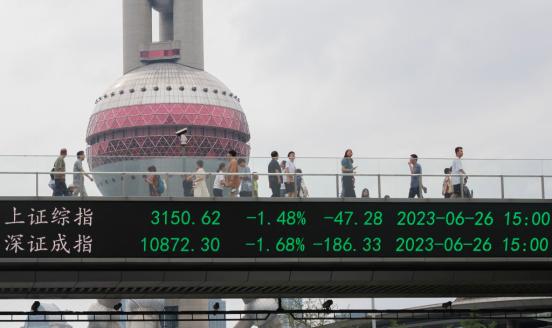CFETS will show which way the Renminbi is heading during the US dollar bull
Currency watchers are sometimes baffled by the role of the CFETS in regulating the relation of RMB to the US Dollar. However, the recent history of CF
This op-ed will be published in Chinese by Hong Kong Economic Journal.

The idea for a RMB exchange rate basket has long been in the air in China. However, it is only since December 2015 that it become a part of the toolkit used by the People's Bank of China (PBoC). At that time, a very strong USD was not sufficient to boost China’s competitiveness, because China’s trading partners depreciated even more against the greenback. Focusing investors’ attention on the RMB’s loss of competitiveness against trading partners was the key reason for the launch of a new basket, namely China’s Foreign Exchange Trade System (CFETS).
The PBoC's addition of CFETS to its toolkit has certainly increased the PBoC's freedom. In fact, when looking at the RMB’s recent evolution, against both the USD and CFETS, it seems quite clear that the RMB has been chasing the weaker of both, mainly depending on the USD cycles. Three periods can be clearly identified when we analyse the movements of the RMB.
(1) The first period began with the announcement of CFETS and continued until the USD started weakening in January 2016. During this time the RMB tended to remain relatively stable against CFETS, but moved relative to the bull dollar.
(2) A second period started with the weakening of the USD in late January 2016 and continued until it started to appreciate again in mid-June 2016 after the UK referendum on Brexit. During this time the RMB did not follow the USD closely, but it did manage to depreciate quite substantially against other trading partners and thus against CFETS.
(3) Finally, the new dollar bull period starting in late June 2016 has resulted in an acceleration of RMB’s depreciation against the USD, while remaining relatively stable against CFETS.
The question really is whether the sudden appreciation of the RMB in early January 2017 will be the start of a fourth period, in which the RMB appreciates against a weakening USD but depreciates against CFETS. I do not believe this will be the case, as I expect the USD to strengthen further (reaching parity against EUR by mid-2017 and depreciation only slightly thereafter up to 1.02). Behind the strong USD, there is my long-standing call for three FED hikes in 2017. In this context, I expect the RMB to continue to depreciate against the USD, albeit at a more moderate rate than in the fourth quarter 2016, with a total drop of of around 4.9% by the end of 2017.
At a time of renewed depreciatory pressure against the RMB, the PBoC – surprisingly for many – announced on 29 December 2016 a revision to the weights of currencies in CFETS. In particular, 11 new currencies were introduced in the basket. Some of the additions were obvious candidates, being currencies of China’s large trading partners. This is the case of the Korean Won (KRW), since Korea is China’s 4th largest trading partner. In fact, the KRW has been assigned a big share of CFETS (10.8%). The rest are relatively minor additions.
But what is clear is that introducing these new currencies automatically reduces the USD weight in CFETS and, therefore, the correlation between CFETS and USD. In fact, the weight of USD or USD-pegged currencies was 33% before and it is now 30.5% (including currencies pegged to the USD such as the HKD).
As a conclusion, many investors wonder whether CFETS can help them guide their expectations on the RMB. Those familiar with Singapore – or other countries officially targeting an exchange rate basket – find CFETS confusing. This is because CFETS seems relevant at some instances but not at others. Within such a framework, the current revision of CFETS’ weights only adds to the confusion for some.
The irony is that the addition of new currencies to the CFETS basket merely adds greater flexibility to the PBoC's toolkit. This should make it clearer to investors that CFETS is what will determine the RMB value for the next few months while we still have a bull dollar period.



